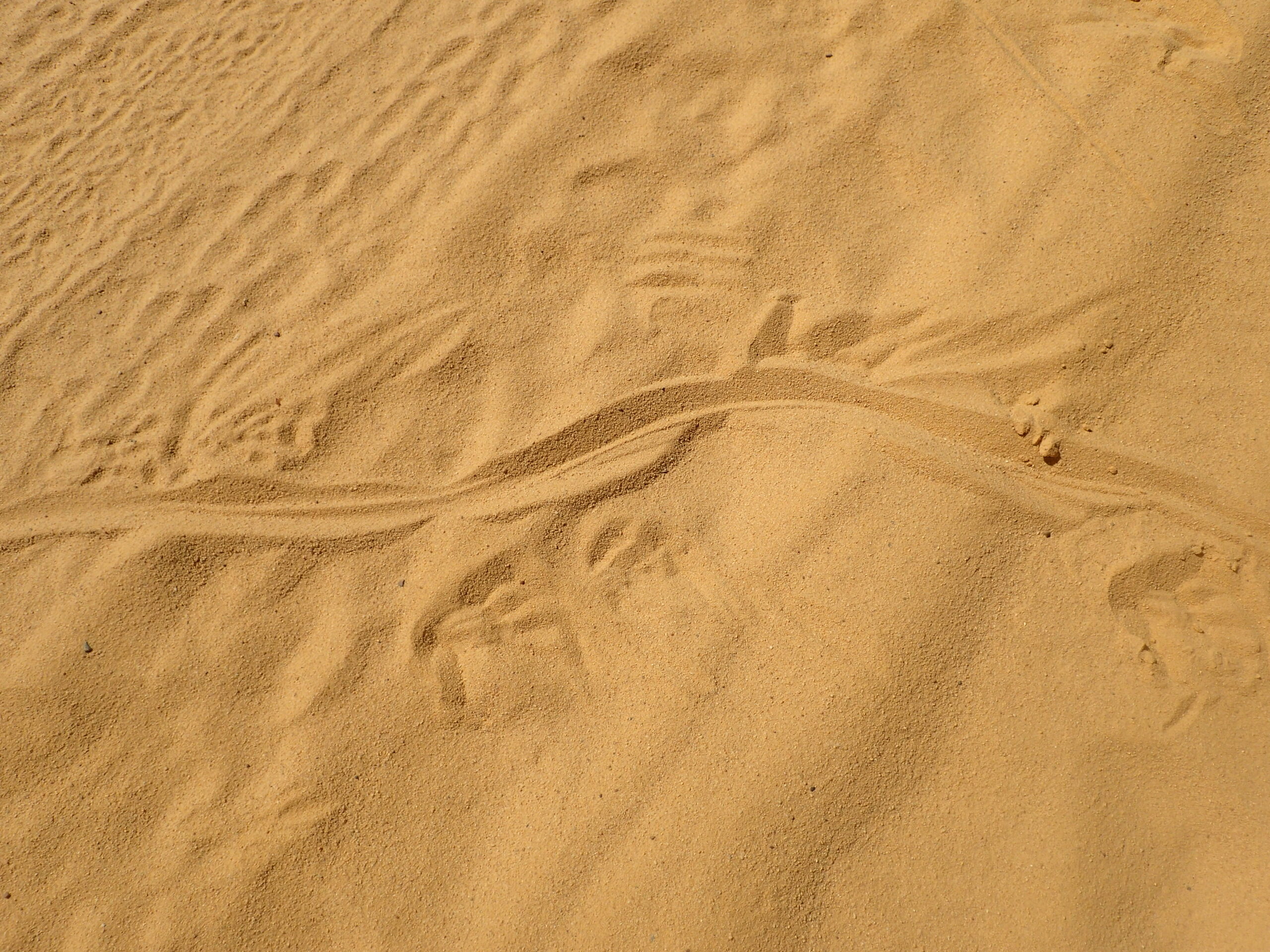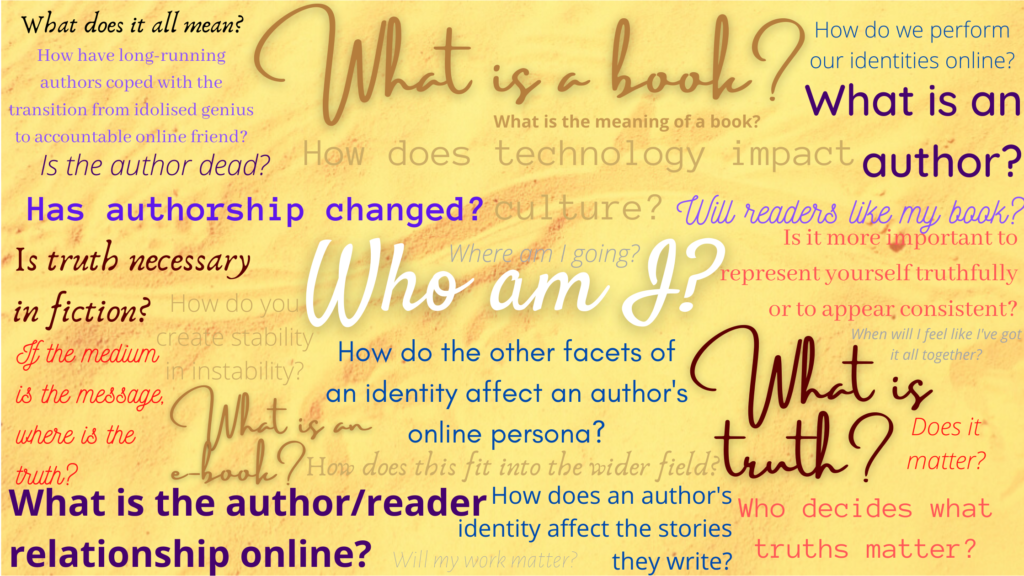So, my first blog post focused on me. Who am I? This one will be much more focused on the creative portion of this practice-based research project, which I currently call Shifting Sands. If you’ve read that first post and/or my About page, you’ll know that the e-book that I’m planning to release in the next few months was created as part of my PhD project, looking at how innovation affects authorship. In the case of Shifting Sands, this innovation is taking a potential trait of the e-book – its ability to be changed even after publication – and playing with it to see if a story that uses this could work and how this changes the way the author acts, readers react, etc. As with the last blog post, I’ll try to answer the questions about Shifting Sands that I can think of, but please do feel free to ask me more below!
What’s the story about?
Shifting Sands revolves around a city trapped in the desert (hence the sandy monster track photo from Australia). The people who live in the City fear the sand, fear outsiders, and fear the monsters that live outside the safety of their walls. Their lives are a struggle as they wait for the return of their goddess. The Temple looms over them all, offering solace to some, but acting as an oppressive ruling force to others.
The story has six characters, though you won’t see all of them all the time. They each offer a different point of view on the struggles of the desert city, with different knowledge and different expectations. Who’s right… well, that’s for you to decide as the reader. Nayoub is a priest who desperately wants to show the Gods just how worthy he is. Kishon is a worker from the city’s Outer Ring, struggling to survive as the desert steals his livelihood and the Temple steals everything else. Aamarin, Nahlena, and Keiziro are all Temple acolytes, with the potential to become one of the head priests who rule the city, but they each struggle against these expectations and their own beliefs. And Aya is a former acolyte, struggling to adjust to a life where she is just an ordinary priest and looking to find something more.
What inspired Shifting Sands?
As with so much of my writing, it all started with a dream. I saw a scene between three of the characters (said scene will now take place in a sequel because word count issues are a thing). They were arguing about magic and who could use it. A few mean words here, a bit more things there, and then suddenly there was water everywhere. I woke up, excited about this world I’d dreamt about, but very confused as to why the water was so important. Creating the world and writing the story was basically me working backwards from there. Water would naturally be important in a desert, so why not make it the source of magic? But which water, and how could its use be restricted?
A less writer-ly inspiration that cannot be denied is the PhD project. Usually when I write, I’m more of a gardener than an architect. I maybe have a vague plan of where I’m going, which moments are going where, but mostly I just let it flow and prune as needed. The story chooses its form. But with this project, I knew more about how it had to look. It had to be created in a way that some parts could be traded in and out without seriously detracting from the story. And, when I first started planning, this was a problem. I’m usually the kind of writer who decides on one character to follow and then builds around that. I may know what’s going on with the others, but it’s fun to hide hints that the character themselves may not understand yet. I wondered, at first, if the story was going to play with the idea of censorship. Perhaps fragments of the story would change subtly over time as the character’s writing was found and adapted to fit the narrative of the Temple in a particular time period. A little 1984-style fantasy, I guess. Or maybe I would change the style of writing to vaguely resemble the history of storytelling, making use of simpler archetypes in the first cycle and then growing outward from there. Then I remembered a book I’d read a while before, Motorbikes and Camels by Nejoud Al-Yagout.
Motorbikes and Camels was a book I stumbled upon when I did some freelancing a few years back. It follows many different characters, giving snapshots into their lives in the chapter devoted to them, and then flitting away to follow another character in the next. As the reader, it takes a while to start seeing how it all fits together and understand the impact each person has in another’s life and I really enjoyed that element of it. While it’s obviously very different from my writing, and I wanted to use the shifting perspectives differently, remembering this book helped me work out where I was going with Shifting Sands. Afterall, the three people I dreamt about had very different points of view (hence the argument), so why not let them each take control of parts of the book to voice these perspectives? Different characters offering their POV for different chapters isn’t new in fantasy, but it was thinking about Motorbikes and Camels that gave me that ‘aha!’ moment.
So how does it work?
My aim is to be as truthful as possible in this blog (hence the repetition that this is all part of a research project) and so, to be completely honest, that’s the bit I’m still fine-tuning at the moment. I do, however, know my current plan for how things will work. The six character perspectives work in pairs. If you see chapters from Kishon’s point of view, you’re not going to see Nayoub’s. If Aya’s there, you’re not getting Keiziro. Nahlena’s there? No Aamarin. This will then shift, with different characters becoming active or inactive on different readings, in the hopes that rereading will bring a new and exciting sense of understanding to the story.
How it will work in a technical sense is slightly more complicated. Kindle, the most popular platform for selling e-books, doesn’t allow the kind of coding I need to do to make this work so it may be that there are two versions of the project. One, non-Kindle version, that is made to change who is active and inactive each time you reach the end of the book. The other, Kindle version, will experience “waves” where I will go in and change things myself. But I’ll post more about that once I’ve worked out the kinks!
Who’s your favourite character?
I’m pretty sure we’re not supposed to have favourites, but… If we’re talking perspective characters, then it’s probably Kishon or Aya. Kishon, partly because I got to write him growing from a child to a young man, was really interesting to write. I got to see what parts of his voice stayed the same and what changed. And, out of all the characters, he has the least to do with the Temple so offers a different view of the City than the others. Aya, meanwhile, just kind of took off on her own. Writing her chapters was the most like my usual form of writing, following the character to see where they wanted to go. And, you know, I’m a sucker for a little romance and I just think she and her girlfriend are cute together.
If we’re not talking perspective characters though, it hands down has to be Masa. Keep an eye out for him – he creeps up everywhere! I guess that’s what makes him so much fun.
So, that’s a little about the book. Feel free to ask more questions – what I think needs to be answered is no doubt very different from what you would actually like to know! And, if you’ve come to this post after the book is out, who was your favourite character?



